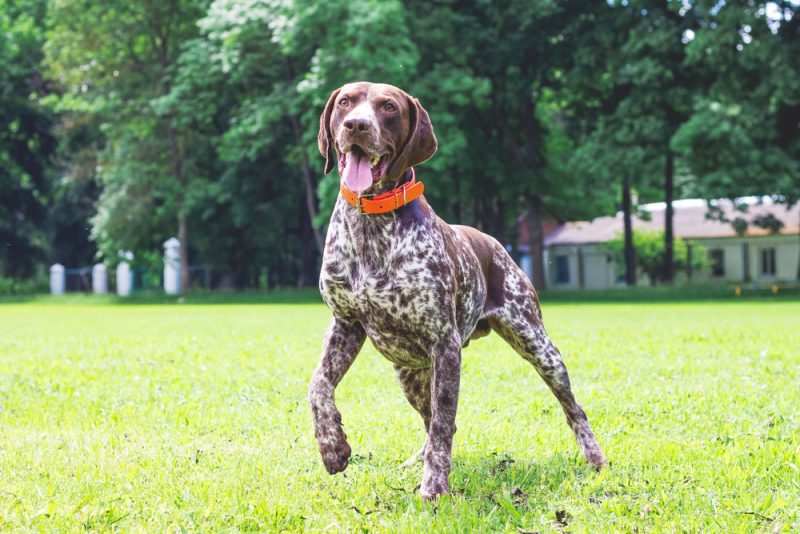Labradoodles have gained popularity over the years, and it’s no wonder why! According to the AKC, their Labrador Retriever is one of the top three most popular dogs. When you add the brains and hypoallergenic qualities of the Poodle, you understand the Labradoodle’s appeal.
The Apricot Labradoodle has a gorgeous tone that accentuates the features of this adorable pup. But where exactly did the color originate? Has it been in the gene pool the whole time or developed slowly with specialized breeding?
Breed Overview
Height:
22–24 inches
Weight:
40–55 pounds
Lifespan:
12–15 years
Colors:
Apricot
Suitable for:
Mild to moderate allergies, growing families
Temperament:
Excitable, loyal, amiable
The Apricot Labradoodle sports a lovely, rusty color with frills and curls. Apricot is one of the most sought-after coat colors and is a lighter version of red. Red is already considered the rarest color, making the Apricot twice as unique. So, don’t be surprised if these puppies are more expensive or if you have difficulty finding one for sale.
Apricot Labradoodle Characteristics

The Earliest Records of Apricot Labradoodles in History
Donald Campbell originally coined the term” labradoodle” in 1955. He used this expression to describe his Poodle/Lab cross.
However, Labradoodles didn’t perform service roles, like being a guide or emotional support animal, until roughly 1989. Wally Conron crossed the two breeds to create a guide dog for a woman whose husband was allergic to dogs.
Since Labradoodles are hybrids, they’re much less regulated, and therefore, you have to be careful when adopting one from a breeder. They may not be held to the same standards as purebreds.

How the Apricot Labradoodle Gained Popularity
Since the Apricot Labradoodle is so rare, they are highly attractive to potential buyers. Since it’s a coat color you don’t see every day, more pet parents are willing to wait for puppies to get the coat color they want.
Labradoodles, as a whole, gained popularity for obvious reasons. They are hypoallergenic, extremely social with families, and make wonderful all-around pets. Often, allergy sufferers might like a specific breed but cannot adopt them due to their allergies. If someone loves Labs but cannot handle the dander from their shedding, getting a Labradoodle may be a practical alternative.
Formal Recognition of Apricot Labradoodles
Labradoodles are considered designer dogs and are not recognized formally by the AKC. However, in Australia, the Labradoodle is highly regulated. Despite formal recognition, breeders worldwide must ensure they produce healthy pups. Each litter should be properly vetted, including vaccinations, microchipping, and general care. Breeders still charge a hefty price tag for these dogs, sometimes over $2,500.
Researching reputable breeders when buying the Labradoodle is vital, no matter what color you choose. Since apricot is such a rare color, be understanding if you need to wait or travel to obtain one.
It is unclear whether the AKC will ever standardize hybrid dogs. As of now, the Labradoodle and several other crosses are not recognized by formal associations.

Top 5 Unique Facts About the Apricot Labradoodle
Here are some astonishing facts about Labradoodles to help you understand what they’re like as a breed. Since the apricot color falls into the mix, here are fun facts about Labradoodles in general.
1. Labradoodles Are Often Tasked as Service Dogs
Labradoodles are highly desirable for service roles. Their temperament, intelligence, and trainability make them excellent candidates for these roles. Labradoodles also make terrific guide dogs, emotional support animals, and diabetic dogs.
Some of these roles require extensive training. So, if you find an Apricot Labradoodle fully trained for a specific task, you can expect to pay several thousand dollars.

2. Red Labradoodles Are the Hardest to Breed
Red is a recessive color in the Labradoodle gene pool. That means it’s often skipped over by stronger genetics that come through in the litter. Red can come through in several tones, leaving no two exactly the same.
It can be on one extreme of the spectrum, closer to a deep, rusty red or cream color. The Apricot and Apricot Cream coat colors fall into this category since they are both dilutions of the standard red.
3. There Are Many Other Coat Colors Outside of Apricot
Since the Labradoodle can carry traits from either parent, you have a whirlwind of coat color possibilities.
- Chocolate
- Café
- Parchment
- Caramel
- Apricot
- Apricot Cream
- Raven Black
- Light Blue
- Parti
- Phantom
Even though these are established collars, they can have variations. Labradoodles come in all sorts of beautiful tones, making each one unique and adorable.
4. The Labradoodle Can Suffer from a Few Health Issues
Like any other dog, Labradoodles can suffer from health conditions. Many are genetic and, therefore, can be controlled with reputable breeding. However, it’s still nice to be aware of the potential problems you could face when owning one of these beautiful dogs.
- Hip dysplasia
- Progressive retinal atrophy
- Von Willebrand’s disease
- Addison’s disease
Most of the time, Labradoodles are healthy and fit. It’s up to us to provide the proper environment, diet, and vetting schedule to promote optimal health in our pets.
5. Labradoodles Were Used in the Entertainment Industry
Fang, a Labradoodle, had a recurring role on the hit show Get Smart in 1965. Fang was much-loved when he took the limelight. He was always in good spirits, charming audiences all over.
Fang might look slightly different from the Labradoodles you see today, but he remains one of the most adorable!


Does an Apricot Labradoodle Make a Good Pet?
Labradoodles make excellent pets no matter what color they are. The coat color does not influence temperament, so your expectations should be the same. Labradoodles are incredibly friendly and love being part of the family.
They can simply be a family companion or become skilled service dogs with the appropriate training. Since they are so intelligent and easy to work with, they make some excellent candidates for service roles.
Labradoodles generally get along very well with other pets, primarily when raised alongside them. However, they were initially bred for hunting and can have a higher prey drive. This characteristic might make them incompatible with farm animals and some small pets.
Like any other dog, Labradoodles must be well-socialized and appropriately trained to achieve their full potential. Otherwise, they might develop nervous or destructive behavioral tendencies.

Final Thoughts
Now that you know a little bit more about the Apricot Labradoodle, you can understand why you might see higher price tags and lower availability. The apricot coat color is something special, so prepare to be on long waiting lists to get one in some cases.
Always look for reputable breeders that have a history of quality litters. Steer clear of backyard breeding since Labradoodles are much harder to regulate.
- Related Read: Labradoodle Colors and Patterns (with Pictures)
Featured Image Credit: Nynke van Holten, Shutterstock


















